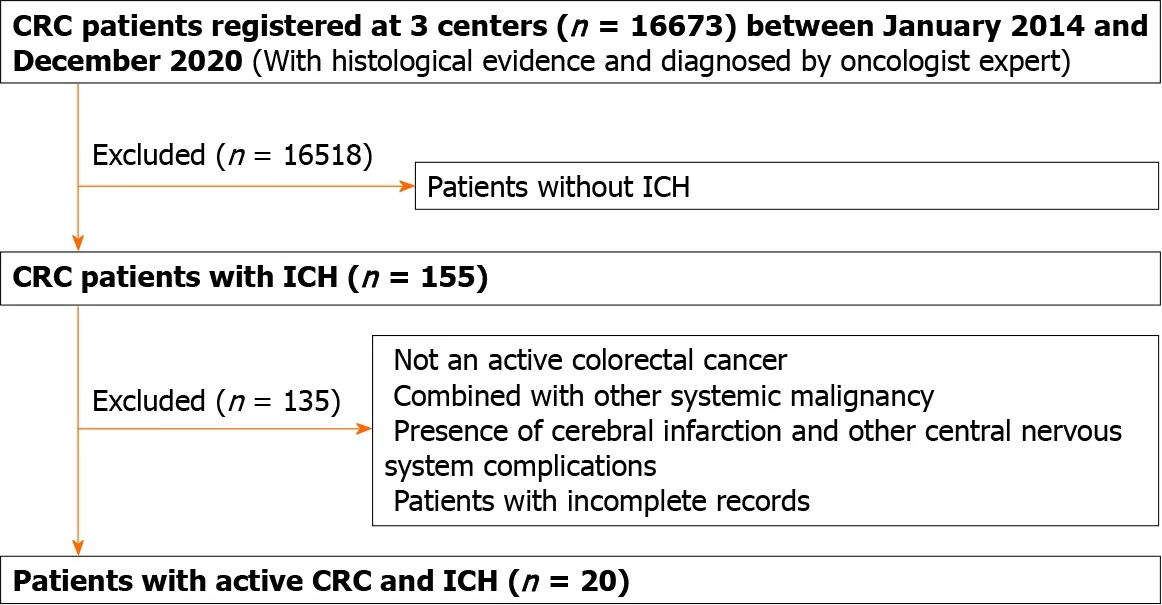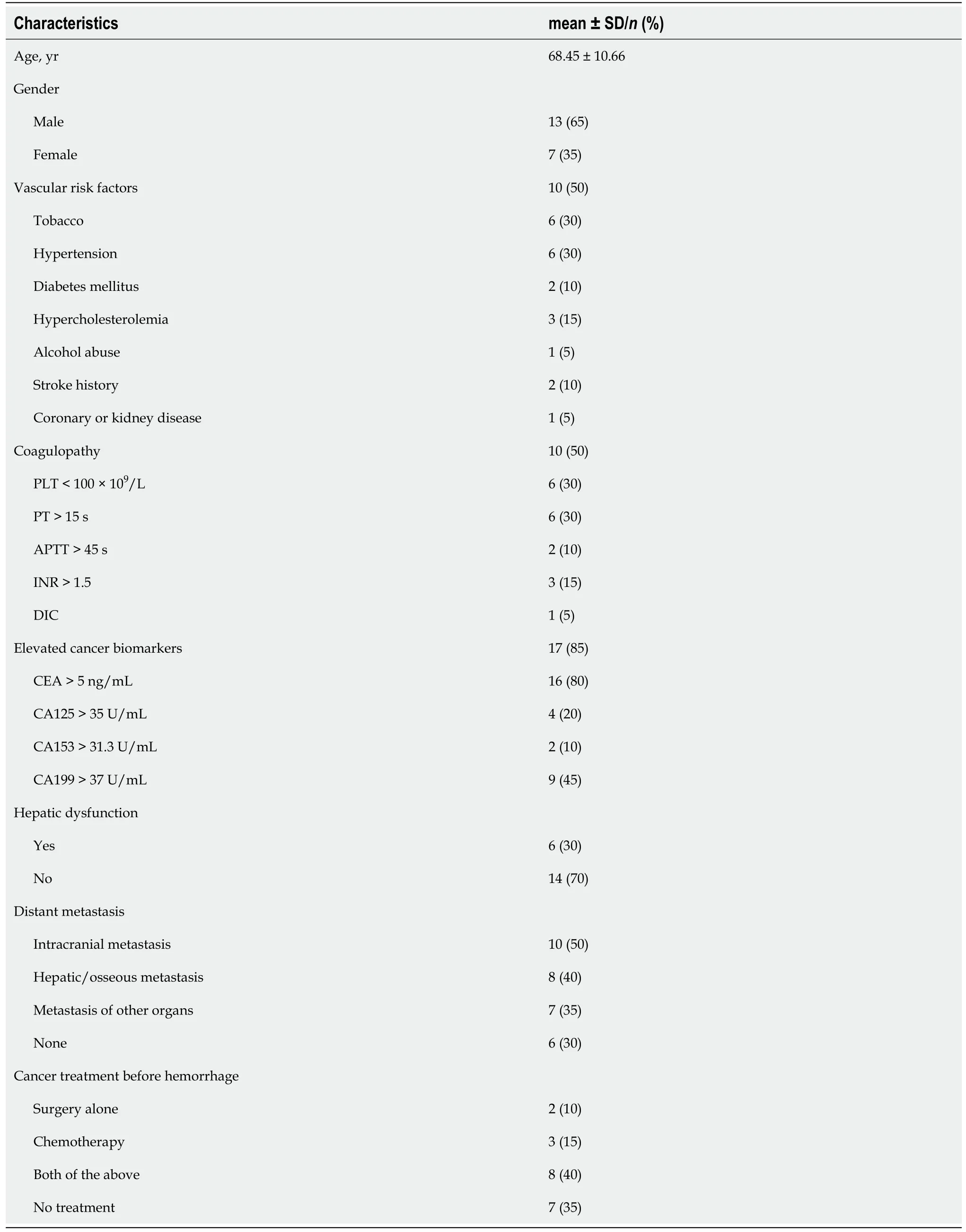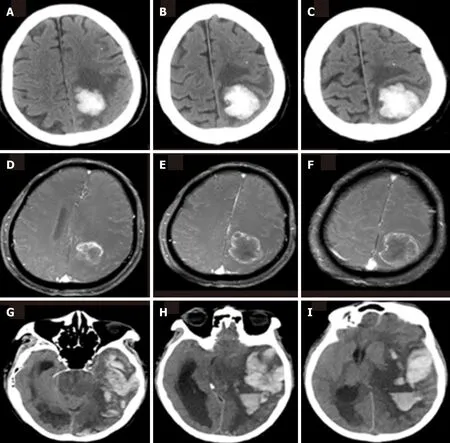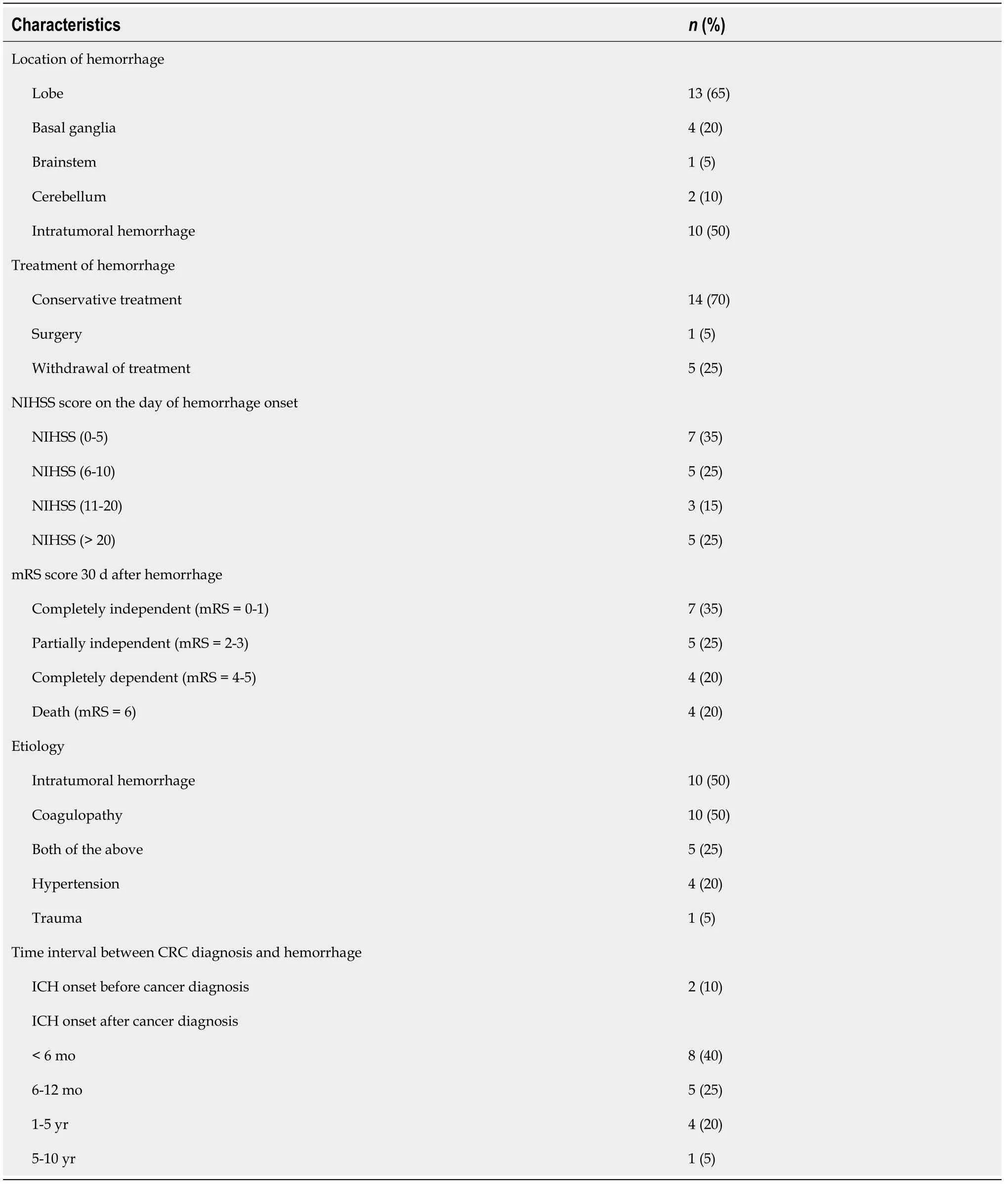Clinical features of intracerebral hemorrhage in patients with colorectal cancer and its underlying pathogenesis
Xu-Hui Deng,Jing Li,Shi-Jian Chen,Yi-Ju Xie,Jian Zhang,Geng-Yu Cen,Yi-Ting Song,Zhi-Jian Liang
Xu-Hui Deng,Shi-Jian Chen,Yi-Ju Xie,Jian Zhang,Geng-Yu Cen,Yi-Ting Song,Zhi-Jian Liang,Department of Neurology,The First Affiliated Hospital of Guangxi Medical University,Nanning 530021,Guangxi Zhuang Autonomous Region,China
Xu-Hui Deng,Department of Neurology,The Affiliated Yuebei People’s Hospital of Shantou University Medical College,Shaoguan 512025,Guangdong Province,China
Jing Li,Department of General Medicine,The Affiliated Cancer Center of Guangxi Medical University,Nanning 530021,Guangxi Zhuang Autonomous Region,China
Abstract BACKGROUND The diagnosis of both cancer and intracerebral hemorrhage (ICH) in the same patient is not uncommon,but the clinical features and pathogenesis of patients with colorectal cancer (CRC) and ICH are still not well known.AIM To investigate the clinical features and underlying pathogenesis of ICH in patients with CRC.METHODS A retrospective review of CRC patients complicated with ICH from three centers between January 2014 and December 2020 was performed.Clinical data such as laboratory examinations,imaging features,prognosis,and underlying pathogenesis were analyzed.RESULTS Of 16673 identified CRC patients,20 (0.12%) suffered from ICH.There were 13 males and 7 females,with an average age (mean ± SD) of 68.45 ± 10.66 years.Fourteen patients (70%) had distant metastases and most patients (85%) showed an elevation of one or more cancer biomarkers.The hemorrhagic lesions in 13 patients (65%) were in the intracerebral lobe.Four patients were completely dependent and 4 died within 30 days after hemorrhage.Intratumoral hemorrhage(50%) and coagulopathy (50%) accounted for the majority of hemorrhages.CONCLUSION Patients with ICH and CRC often have clinical features with lobar hemorrhage,distant metastases and poor prognosis.Intratumoral hemorrhage and coagulopathy are the main causes of ICH in patients with CRC.
Key Words:Colorectal cancer;Intracerebral hemorrhage;Clinical features;Pathogenesis
INTRODUCTION
Intracerebral hemorrhage (ICH) and cancer are both common disorders,and are significant causes of morbidity and mortality worldwide in the elderly.It is reported that ICH accounts for almost half of cerebrovascular events in cancer patients[1,2] and significantly aggravates their condition and prognosis[3,4].Several population-based studies have demonstrated that multiple cancers are associated with an increased risk of ICH[5,6].Despite the fact that traditional vascular risk factors for ICH are commonly observed in cancer patients,current studies have revealed that ICH in some patients shows clear-cut distinctions by its unique characteristics and pathogenesis.ICH can manifest as direct or indirect effects of cancer,namely cancer-related ICH.Cancer-related ICH might result from primary or metastatic brain malignancies,coagulopathy or systemic effects of oncological therapy[1,7,8].However,it may lead to a variety of clinical features and pathogenesis of cancer-related ICH due to the complexity and diversity of cancers.
Colorectal cancer (CRC) is the third most frequently diagnosed cancer in the world[9,10].It has been estimated that CRC burden rose to approximately 1.9 million new cases and 0.9 million deaths worldwide in 2020[10].However,there are few detailed reports in the literature that focus on the hemorrhagic cerebrovascular events in CRC patients.The purpose of this study was to investigate the clinical features and underlying pathogenesis of ICH in patients with CRC.
MATERIALS AND METHODS
The present study was reviewed and approved by the Ethics Committee of the First Affiliated Hospital of Guangxi Medical University.CRC patients with ICH were recruited from the First Affiliated Hospital and the Affiliated Cancer Center of Guangxi Medical University,and the Affiliated Yuebei People’s Hospital of Shantou University Medical College between January 2014 and December 2020.The diagnostic criteria for ICH were based on the 2015 Guidelines for the Diagnosis and Treatment from the American Heart Association[11].The diagnosis of active CRC followed the definition of active cancer in the study by Leeet al[12].Patients who met the following criteria were included:(1) Diagnosis of CRC within 6 mo before enrollment,any treatment for CRC within the previous 6 mo,or recurrent or metastatic CRC;(2)Presence of clinical symptoms,such as sudden onset of unconsciousness,headache,hemiplegic paralysis,slurred speech,or other focal neurological deficits;and (3) The presence of ICH on intracranial computed tomography (CT) or magnetic resonance imaging (MRI) scan and susceptibility-weighted imaging,which could explain the symptoms.The exclusion criteria were as follows:(1) Combined with other systemic malignancy;(2) Presence of cerebral infarction and other central nervous system complications;(3) CRC diagnosed > 5 years ago,with no evidence of recurrence or metastasis;and (4) Patients with incomplete records (Figure 1).The selected cases were reviewed and determined by a panel which consisted of an oncologist,a neurologist and a neuroradiologist who were all blind to the study.

Figure 1 Patient enrollment flowchart.
Collection of clinical data
General demographic data such as age and gender were obtained.Vascular risk factors for ICH including hypertension,diabetes mellitus,hypercholesterolemia,tobacco and alcohol consumption,aneurysm,arteriovenous malformation and stroke history were also documented.Moreover,data on CRC,such as pathological types of cancer cells,metastasis,prior and current treatment and information related to acute ICH,including onset form,cardinal symptoms and signs,and hemorrhagic locations were recorded.In addition,routine blood examination,blood biochemistry,coagulation indices,plasma D-dimer,cancer biomarkers,electrocardiography,Doppler echocardiography,cervical vascular Doppler,head and neck CT angiography,head CT,head MRI and magnetic resonance angiography were also carried out.The National Institute of Health Stroke Scale (NIHSS) was used to evaluate the severity of focal neurological deficits.To minimize the effects of CRC progression on physical activities,patients’ functional prognosis on the 30th day after hemorrhage was measured using the modified Rankin Scale (mRS),and a mRS score > 3 was regarded as a poor prognosis[13].According to a research study by Navi and colleagues on ICH[2],coagulopathy was identified if any of the following parameters were fulfilled:platelets<100 × 109/L,international normalized ratio (INR) > 1.5,activated partial thromboplastin time (APTT) > 45 s,prothrombin time (PT) > 15 s,and disseminated intravascular coagulation (DIC) (fibrinogen<200 mg/dL and D-dimer > 290 ng/dL).
Statistical analysis
All statistical analyses were undertaken using SPSS 20.0 software (IBM,Inc.,Armonk,NY,United States).Quantitative data were shown as mean ± SD and qualitative data were expressed as frequency and percentages.
RESULTS
A total of 16673 patients with CRC were identified,and 20 patients (0.12%) with ICH met the inclusion criteria.Of these 20 patients,13 were male (65%) and 7 were female(35%).The average age (mean ± SD) was 68.45 ± 10.66 years (range 47-82).All patients were pathologically confirmed to have adenocarcinoma.Ten patients had vascular risk factors,including tobacco use (30%),hypertension (30%),diabetes mellitus (10%),alcohol abuse (5%),hypercholesterolemia (15%),stroke history (10%) and coronary or kidney disease (5%).No aneurysms or arteriovenous malformations were identified in these patients.None of the patients were on therapeutic anticoagulation or antiplatelet agents at the time of hemorrhage.Coagulopathy was observed in 10 patients.Thrombocytopenia was present in 6 patients (30%).Six patients (30%) had a prolonged PT value,2 (10%) had a prolonged APPT value,and 3 (15%) displayed INR values greater than 1.5.DIC was documented in 1 patient.Most patients (17/20,85%) had at least one elevated cancer biomarker.Six patients (30%) showed hepatic dysfunction,while 14 patients (70%) did not.Fourteen patients (70%) exhibited distant metastases,intracranial metastasis occurred in 10 patients (50%) and hepatic/osseous metastases occurred in 8 patients (40%),when ICH developed.Prior to hemorrhage,13 patients(65%) had received oncological therapy while 7 patients (35%) had not (Table 1).

Table 1 Demographics of colorectal cancer patients with intracerebral hemorrhage
ICH occurred in 2 patients (10%) before cancer diagnosis and 18 patients (90%) after cancer diagnosis.The most frequent hemorrhagic lesion was in the cerebral lobe,occurring in 13 patients (65%).Fewer lesions were found in the basal ganglia (4/20,20%),cerebellum (2/20,10%),and brainstem (1/20,5%).The etiologies of hemorrhage were ascribed to intratumoral hemorrhage (10/20,50%),coagulopathy (10/20,50%),both intratumoral hemorrhage and coagulopathy (5/20,25%),hypertension (4/20,20%),and trauma (1/20,5%).Fifteen patients (75%) received hemorrhage targeted treatment and 5 (25%) withdrew treatment.The mean NIHSS score was 10.25 ± 7.59(range 2-25) on the day of hemorrhage onset.On the 30th day after hemorrhage,7 patients (35%) were completely independent,5 (25%) were partially independent,4(20%) were completely dependent,and 4 (20%) died (Table 2).Among the 4 patients who died,the cause of death was fatal ICH induced by DIC in one patient,brain metastasis and intratumoral hemorrhage in one patient,and aspiration pneumonia in the other two patients (Figure 2).

Figure 2 Neuroimaging findings.

Table 2 Data on intracerebral hemorrhage
DISCUSSION
ICH is a well-known potential complication of cancer[1,2].A nationwide follow-up study from Sweden reported that compared with a non-cancer population,the overall risk of hemorrhage after diagnosis of cancer within 6 mo,6 mo to 1 year and 1 year to 5 years was 2.2,1.4 and 1.3,respectively[6],indicating that cancer could increase the incidence of ICH and that cancer-related ICH theoretically exists.Patients with CRC also had a significantly increased risk of hemorrhage[6].CRC-related ICH may also theoretically exist.In this study,although only 0.12% of CRC patients developed ICH,the incidence of hemorrhage was still much higher than that in the general population.Traditional pathogenesis were observed in the etiology of ICH in CRC patients,but more attention should be paid to the direct or indirect role of CRC itself.
In a retrospective review,cancer patients with ICH were more likely to present with coagulopathy,a lobar hemorrhage location,and poor short-term prognosis when compared with non-cancer patients[14].In the present study,hemorrhagic lesions were more frequent in the cerebral lobe,occurring in 13 of 20 patients,and the shortterm prognosis was poor,as disability and death occurred in 8 of these 20 patients within 30 d after hemorrhage onset.Coagulopathy was identified in half of the patients.In some respects,the results of this study were consistent with the research stated above.In addition,most patients developed distant metastases and had significantly elevated cancer biomarkers when ICH occurred,which was another characteristic in CRC patients with ICH.
Although ICH is a late complication in most cancer patients,it may precede cancer diagnosis.It is worth noting that 2 patients were newly diagnosed with CRC during hospitalization for ICH,suggesting that ICH might be the first manifestation of CRC.Cancers with ICH as the initial symptom include choriocarcinoma,leukocythemia,and medulloblastoma[15-17].How to quickly identify insidious cancer in patients with ICH is still a challenge.Therefore,it is necessary to conduct cancer associated examinations,including CRC associated examinations,in patients with unexplained hemorrhage.
ICH in patients with cancer often arises from unique mechanisms which are uncommon in the general population.A clinical series of 208 cancer patients with intracranial hemorrhage found that intratumoral hemorrhage and coagulopathy were the main causes,and that hypertension,the most common cause of ICH in the population,accounted for only a small proportion[2].In the present study,ICH was caused by hypertension in a small number of patients but was mostly caused by intratumoral hemorrhage and coagulopathy,which was similar to the above results,indicating that intratumoral hemorrhage and coagulopathy might be the main pathogenesis of ICH in patients with CRC.
Pathophysiologically,factors favoring intratumoral hemorrhage include tumor necrosis,aberrant neovascularization,vascular infiltration with rupture,imbalances in the fibrinolytic cascade,and overexpression of vascular endothelial growth factor(VEGF) and metalloproteinases[1-2,18,19].Tumor cells can directly invade blood vessels and destroy their integrity,resulting in vascular rupture.Overexpression of VEGF in tumor cells can stimulate neovascularization and increase microvessel density.However,the fine structure of newly formed blood vessels induced by VEGF tends to have high permeability and fragility leading to hemorrhagic events[19].Abnormal high expression of metalloproteinases can degrade extracellular matrix proteins which maintain basement membrane structural/functional integrity,and cause considerable damage to capillary integrity leading to hemorrhage[19].Overexpression of VEGF in CRC cells has been confirmed,and anti-VEGF therapies have been proved to be effective for metastatic CRC[20,21].The expression and activity of metalloproteinases are high in CRC cells[22],and matrix metalloproteinase inhibitors might be a new way of treating metastatic CRC.
Coagulopathy is typically related to a complex interplay of multiple mechanisms,including thrombocytopenia,coagulation factor abnormalities or both.The etiology of thrombocytopenia can be diverse and multifactorial in cancer patients.Systemic chemotherapy is the most common cause of bone marrow suppression and thrombocytopenia[23].In patients with solid tumors,thrombocytopenia is potentially associated with bone marrow metastasis of malignant cells and secondary myelofibrosis[24].Metastatic malignant cells can interfere with the hematopoietic microenvironment and inhibit hematopoiesis.Myelofibrosis may be induced by a series of cytokines secreted by immune system cells as part of the inflammatory response to tumors.In addition,DIC,thrombotic thrombocytopenic purpura,immune-mediated thrombocytopenia and heparin-induced thrombocytopenia all contribute to increased platelet destruction in cancer patients[24].In this study,some patients had been treated with chemotherapy before hemorrhage,and hence it is reasonable to consider chemotherapy as a significant risk factor.Some patients had osseous metastases,and it was speculated that their thrombocytopenia was related to bone marrow metastasis.Abnormalities in coagulation factors generally result from hepatic dysfunction,vitamin K deficiency or DIC.Hepatic dysfunction in some patients may be related to a primary or metastatic liver tumor,and chemotherapy.The production of coagulation factors may be affected in patients with obvious hepatic dysfunction,which may lead to a deficiency in coagulation factors.Patients with advanced cancer often suffer from severe malnutrition due to insufficient food intake,and the shortage of multiple nutrients,especially vitamin K,further aggravates their coagulopathy.DIC is the most serious form of coagulopathy.The combination of excessive consumption of coagulation factors and platelets and primary fibrinogenolysis account for the high risk of bleeding during the pathological process of DIC.It is reported that CRC can also present with DIC during treatment[25,26].In the present study,some patients had liver metastases,obvious hepatic dysfunction and poor nutrition,which may have resulted in coagulation factor deficiency.One patient developed DIC during treatment,resulting in fatal ICH.
CA125,CA153,CA199 and CEA are widely used as common cancer biomarkers in the clinic,and are well known carcinoma mucins.Previous studies revealed that carcinoma mucins were overexpressed by malignant cells and were shown to play a multifaceted role in the initiation,progression,metastasis and subsequent colonization of multiple malignancies[27,28].In a clinical study of lung cancer-related ICH,elevated plasma CEA and CA199 Levels were independent risk factors for ICH in patients with active lung cancer[13].The researchers hypothesized that elevated cancer markers could activate platelets and lead to increased platelets,hypercoagulability,and eventually thrombotic events in the early stage of cancer;however,in the later stage,elevated cancer markers could lead to decreased platelets due to consumption,coagulopathy,and finally hemorrhagic events.Significantly elevated cancer biomarkers were observed in most patients in this study,but the role of these biomarkers in ICH requires further research.
The pathogenesis of ICH induced by CRC is complex and has not been fully elucidated.To date,there is no feasible method to effectively prevent and treat ICH in patients with CRC.In view of the pathophysiological changes such as thrombocytopenia and abnormalities of coagulation factors,it is possible to take active measures,including increasing nutrition supply,and supplementing platelets and fresh plasma,to improve the coagulation state in the early stage.These measures may delay or reduce the occurrence of ICH in patients with CRC,but should be confirmed in future studies.
One of the limitations of this study is its retrospective nature;thus,information bias may exist.Although clinical data were collected from three centers,the total number of selected cases was relatively small.Prospective population-based cohort studies are warranted to better elucidate the clinical characteristics and pathogenesis of CRC patients with ICH.
CONCLUSION
Patients with ICH and CRC often have clinical features with lobar hemorrhage,distant metastases and poor prognosis.Intratumoral hemorrhage and coagulopathy are the main causes of ICH in patients with CRC.More clinical trials are needed to validate these findings in the future.
ARTICLE HIGHLIGHTS
Research background
Many studies have confirmed that cancer can increase the risk of intracerebral hemorrhage (ICH).However,most previous studies were conducted on multiple cancers,and few focused on a specific cancer.The clinical characteristics and mechanisms of ICH in colorectal cancer (CRC) patients have not been fully elucidated.
Research motivation
There are few reports on hemorrhagic cerebrovascular events in patients with CRC.
Research objectives
This retrospective study aimed to investigate the clinical features and underlying pathogenesis of ICH in patients with CRC.
Research methods
A retrospective review of 20 patients (13 males and 7 females) with CRC and ICH from three centers between January 2014 and December 2020 was conducted.The clinical data of the patients such as vascular risk factors,laboratory results,neuroimaging and underlying pathogenesis were analyzed.
Research results
The average age (mean ± SD) of the patients was 68.45 ± 10.66 years.Fourteen patients(70%) had distant metastases and most patients (85%) had an elevation of one or more cancer biomarkers.The hemorrhagic lesions in 13 patients (65%) were in the intracerebral lobe.Four patients were completely dependent and 4 died within 30 days after hemorrhage.Intratumoral hemorrhage (50%) and coagulopathy (50%) accounted for the majority of hemorrhages.
Research conclusions
Patients with ICH and CRC often have clinical features with lobar hemorrhage,distant metastases and poor prognosis.Intratumoral hemorrhage and coagulopathy are the main causes of ICH in patients with CRC.
Research perspectives
The detailed mechanism of ICH in CRC patients requires further elucidation.Prospective population-based studies are needed to confirm these findings in the future.
 World Journal of Gastrointestinal Oncology2021年12期
World Journal of Gastrointestinal Oncology2021年12期
- World Journal of Gastrointestinal Oncology的其它文章
- Management of obstructive colon cancer:Current status,obstacles,and future directions
- Role of endoscopic ultrasound in anticancer therapy:Current evidence and future perspectives
- Mesenchymal stem cell-derived exosomes for gastrointestinal cancer
- Gender differences in the relationship between alcohol consumption and gastric cancer risk are uncertain and not well-delineated
- Pancreatic intraductal papillary mucinous neoplasms:Current diagnosis and management
- Combined treatments in hepatocellular carcinoma:Time to put them in the guidelines?
